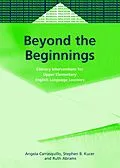The book addresses upper elementary English language learners who have a fairly good knowledge of spoken and written English, have demonstrated knowledge of phonemic awareness, phonics, decoding and word recognition, yet are struggling with academic English literacy. Throughout the book, the authors continuously argue that planning and delivering instruction to these students must be based on the ELL's existing competencies, prior knowledge and experiences. Classroom curriculum and instruction must provide opportunities for helping ELL learners to build and extend skills, knowledge and processes. And, the highly complex process of language learning and literacy development calls for multifaceted instructional approaches. The book is divided into eight chapters providing specific information on the diversity of ELLs and providing examples, models and strategies to move them beyond the transition in English reading and writing.
Autorentext
Angela Carrasquillo is a professor at Fordham University Graduate School of Education where she is the coordinator of the TESOL Program. She is nationally known in the areas of second language and bilingual education and has published extensively in these fields. She is the author (with Vivian Rodríguez ) of Language Minority Students in the Mainstream Classroom (Multilingual Matters, 2002).
Stephen B. Kucer is an associate professor of language and literacy education in the Graduate School of Education at Fordham University Lincoln Center. He is the author of Dimensions of Literacy (Erlbaum) and co-author of Curricular Conversations (Stenhouse).
Ruth Abrams works for the New York City Department of Education as a teacher of English to Speakers of Other Languages. She is also on the adjunct faculty of Fordham University Graduate School of Education where she teaches courses in literacy and TESOL.
Inhalt
Acknowledgments
Introduction
Organization of the Book
1 English Language Learners in United States Schools
2 English Literacy Development and English Language Learners: A Theoretical Overview
3 Moving Beyond the Transition: Struggling English Literacy Learners in the Regular/Mainstream Classroom
4 Instructional Writing Strategies for Struggling English Language Learners
5 Instructional Practices to Promote Reading Development in English Language Learners
6 English Literacy Across the Curriculum
7 A Framework for Assessing English Literacy Among Struggling English Language Learners
8 Developing Collaborative Literacy Relationships with Parents
Resources for Teachers of ELL Students
References
Index
